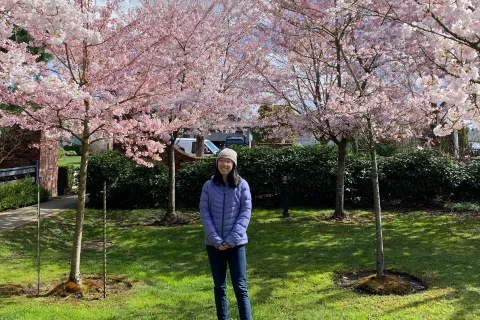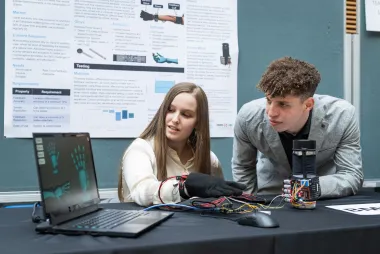”Finding your place in the world is a lifelong journey“

Kira Li
- Degree:
- Bachelor of Applied Science
- Program:
Hi! I’m Kira, I’m going into my fourth year of biomedical engineering in the cellular bioengineering stream. Throughout my program, I have gotten involved in many opportunities that have enhanced my learning. I joined the UBC Bionics design team, where I gained skills in data science to analyze signals such as EMG and EEG. It’s cool to contribute my small part to improve the design of bionic devices. I am also part of the UBC Engineering co-op program, which has helped me secure 2 co-op positions. The co-op program allowed me to explore different types of work in different sectors, such as content creation in STEM education and laboratory assistant in a vaccine company. These experiences have shaped my time at UBC engineering and going forward in future career decisions.
How did you decide your current UBC Engineering discipline, or why did you choose UBC Engineering?
I’ve always loved math and science, so going into university I knew I wanted to enter the Faculty of Science or Engineering. Choosing UBC Engineering has given me many designs, programming, and math skills that serve as the foundation to solve complex problems in diverse contexts. Since I’ve always been drawn to the life sciences and biology, biomedical engineering was the perfect program to learn engineering skills and the necessary biological background. The program is very interdisciplinary, providing endless possible applications to the real world.
What has made your time at UBC Engineering memorable?
I’ve really enjoyed some of the courses I’ve taken, especially biomedical engineering lab and design courses. It was great to get hands-on experience and to get to know people from working on group projects together. In engineering design courses, we have worked on projects such as creating a software application to detect sickle cell disease from microscope images and designing an improved thermal shipping container for temperature-sensitive vaccines.
Tell us about your experience in your program. What have you learned that is most valuable?
In my program, I gained engineering skills such as CAD and programming. I also gained a foundation in the life sciences such as in human physiology/anatomy, biophysics, and immunology. The most valuable skills I have gained are teamwork, effective technical communication, and problem-solving. When facing a challenging problem, it’s essential first to figure out where the hard part is, and then to dive in, learn more and try again. Then, if you’re still stuck, it’s time to find extra resources, discuss with classmates/friends, and/or ask for help from professors and TAs.
What resources or events organized by UBC Engineering have helped you in your academic, professional or entrepreneurial journey thus far?
In academic courses, I have contacted teaching assistants and professors for help through online forums such as Piazza or during office hours. There are also often review sessions before midterms that can help summarize large amounts of content and provide extra practice. Faculty and program-specific events, such as those organized by the Engineering Undergraduate Society (EUS) or Biomedical Engineering Undergraduate Student Association (BMEUSA), have been a great way to get to know other students. Before university, I had minimal work experience, so the co-op program helped me start my professional journey with resources like the job board and resume toolkits.
What is one piece of advice you would share to a student entering UBC Engineering?
University and an academically rigorous program like UBC Engineering is a great opportunity to explore your interests. It’s easy to get into a routine of just completing assignments and checking things off your to-do list, but by becoming connected to the community and taking part in experiences such as design teams or co-op, you can discover what you enjoy and what you don’t. This can help shape the big picture of your life.
Many of today’s jobs did not exist 10 years ago, and we do not know for certain what the workforce will look like 10 years from now. How do you see the remainder of your studies in the Faculty of Applied Science preparing you for the future of work?
I think the pandemic has proven that the future is incredibly uncertain, so it’s important to have a versatile set of skills to adapt to changing situations. Biomedical engineering is an incredibly broad field with many applications that will only become more relevant with an aging population and an emphasis on improving people’s quality of life. My studies have equipped me with the skills needed to be able to solve problems in different contexts and to continue learning in a rapidly advancing industry. Many courses, especially in upper 3rd and 4th years, are related to the most cutting-edge research being done in the field.



